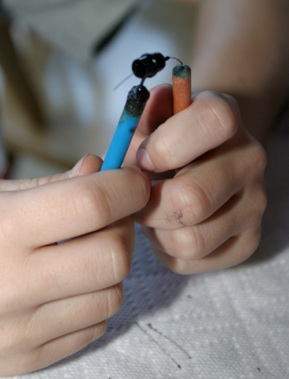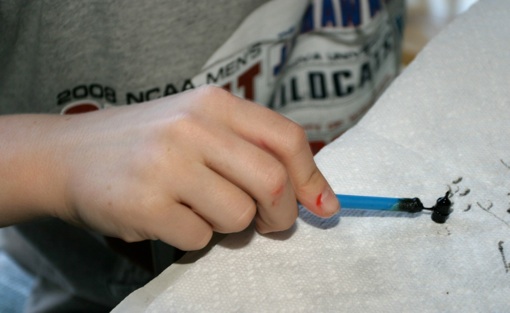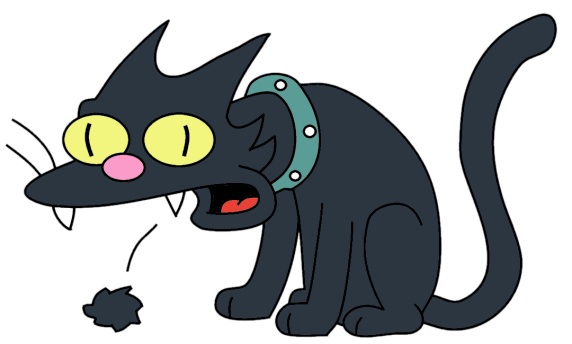Clogged Stylus

Any stylus, from the most narrow tipped one to the widest, can become blocked or clogged up. Debris accumulates in the reservoir and eventually the mass of it is enough to keep the molten wax from flowing smoothly through the tip, if at all.
What causes this blockage? All sorts of debris. The wax can have impurities in it, either natural (bee parts) or added (colorants in darkened wax). The wax can pick up debris either from the air (dust) or from the work area (fibers from the work surface, animal hair if there are pets in the house). And small fibers and other debris can settle into the reservoir itself, especially if the opening is fairly large.
Raw, unfiltered beeswax
I have found that my styluses regularly plug up with small balls of fibers and other debris (“hair balls” or pysanka “bezoars1”); since I use several different types of wax, keep no pets (allergies), and keep my wax covered when not in use, I can only assume that the fibers come from my work surface, a stack of Bounty paper towels.
What can one do about clogged tips? As in medicine, there is prevention and, if that fails, treatment.
PREVENTION:
-
1.Use clean, filtered beeswax. Wax sold for pysankarstvo (or candle-making) has been filtered, with all the bee debris removed. Wax sold at the farmer’s market by your local beekeeper probably hasn’t. If you’re going to economize by using the latter, you may have issues with clogging. And if you melt down beeswax candles for wax, snip the burnt wicks off first.
-
2.Store your beeswax in a closed, air-tight container, such as a jar, tupperware box or baggie, when you’re not using it. This will keep dust and other debris from settling onto your wax. Also, take out only a small amount of wax at a time to minimize exposure to contaminants.
-
3.Keep your work area clean. Minimize dust, cobwebs and pet hair in the vicinity of your work space. Keep pets away, particularly when they’re shedding, and cover or close off your work space, if possible, when not in use.
-
4.Working on a lint-free surface, particularly if clogging is a big problem for you. Avoid most paper towels and all facial tissues. Viva paper towels are fairly lint-free, and might prove a good alternative.
Since doing all of the above is difficult for most of us, we will simply have to deal with clogs. Despite what some would have you believe, it’s really quite simple to clean out your stylus, and nowhere as complex as brain surgery.
While some people regularly scrub down their styluses, and soak them in lighter fluid, I’ve never done either, preferring to clean them only when they obviously need it. This may help to get rid of growing hair balls before they get big enough to cause trouble but, eventually, your stylus will get blocked. How do you clear it out?
(Note: the photos below show a traditional stylus, but the technique is applicable to either traditional or electric styluses.)
I have a simple method that I use to get rid of the blockages:
-
1.If there is little or no wax in the reservoir, add some, enough to fill the reservoir almost completely. I tend to use paraffin from a candle for this, rather than wasting good (and more expensive) beeswax.
-
2.Insert a cleaning wire through the tip and into the reservoir. Move it around to loosen any debris. The wire will push the clog out of the tip itself; agitating the wax will suspend the clog in the wax, making it easier to remove.

-
3.Tap the head of the stylus, reservoir end down, against the table (or other flat surface). This will cause the wax in the reservoir, with the suspended debris/clog, to come out. Do this over a paper towel or some other absorbent (and disposable) material, and not over a bare table.

-
4.Inspect the wax; you should see the clog in it. Also inspect the stylus, looking through the open end of the reservoir and through the tip. If you have cleared it out, you should be able to see through it, particularly in the case of medium or heavy tips. Fine tips might not show light even when clear.
-
5.If you can see the clog and/or light, you are done. If you can’t, repeat these steps.
And that’s it’s – quick and simple. In my experience, 95% of the time a single wire insertion and tap will clear everything out, especially if the blockage is caused by a clump of fibers. In fine or extra fine tipped styluses, the debris plugging the tip can be quite small, and may take a couple of repetitions to clear out.
Keep in mind that, too, that, when working with very fine-tipped styluses (XF, 2XF, 3XF, etc.), it doesn’t take much to plug up the tip. You’ll need to either clean the tip frequently, or use an ultra-filtered wax. The former is a nuisance, but doable. The latter option – using ultra-filtered wax – can be problematic, as the ultra-fine waxes can smear or lift more easily than regular beeswax, particularly in warm weather. Filtering the wax can remove the components which allow it to harden (i.e. which raise the melting point).
___________
-
1.trichobezoar is the scientific term for a ball of hair that collects in an animal’s stomach but fails to pass through the intestine. These occur commonly in cats, who swallow the hair when they groom themselves.
Back to Main Wax Lines page
Back to Main Pysankarstvo page
Search my site with Google
Cleaning out the tip of your stylus

One way to get rid of a hair ball........




